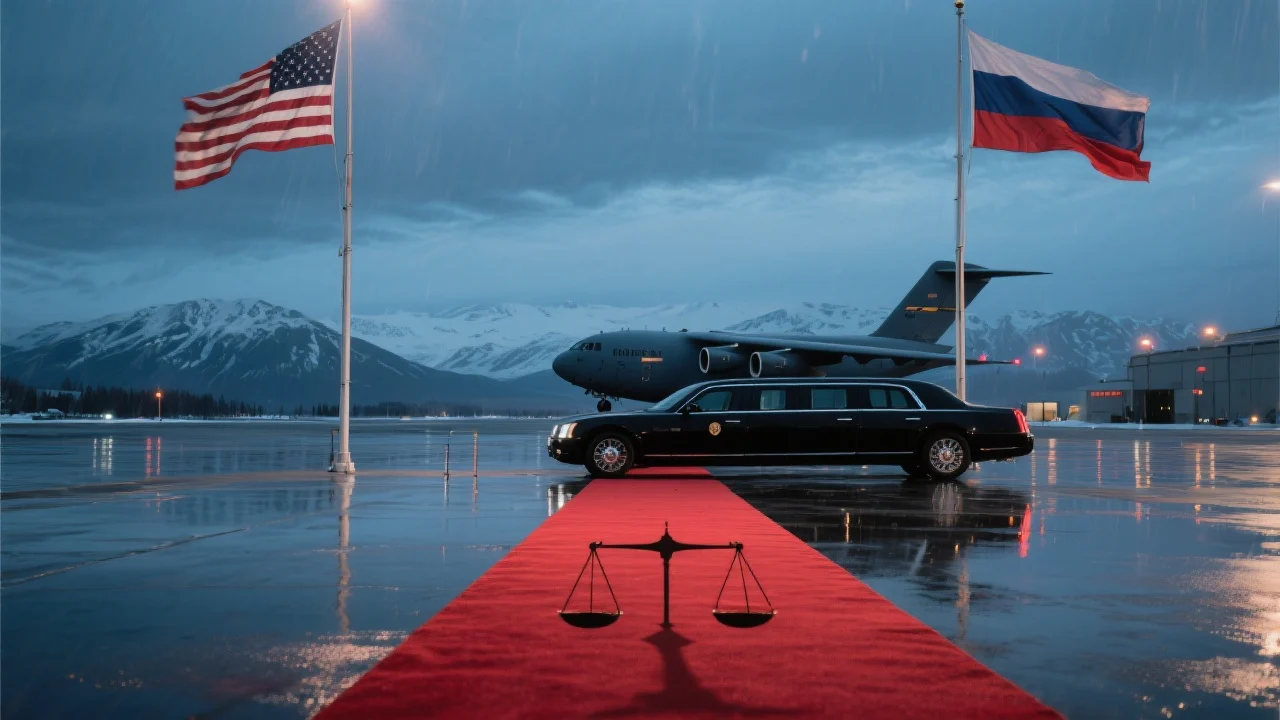
The tableau said more than the talking points. At the Trump Putin summit in Alaska, Vladimir Putin stepped onto Alaskan tarmac to a literal red carpet Anchorage Joint Base Elmendorf Richardson crews had unfurled before dawn.
The optics
Donald Trump greeted him and ushered him into The Beast for a private drive to their meeting site in Anchorage. After nearly three hours, the two men appeared for a brief press event that took no questions. Putin spoke for roughly eight and a half minutes. Trump spoke for a little over three. Then they were gone. No deal after the Trump Putin summit. No ceasefire. No next steps the public could parse.
If politics is theater, this Trump Putin Anchorage meeting was a production that granted Putin the stage he wanted and denied the audience a plot.
What was actually said
On substance, the clearest specifics came not from the podium but from a friendly TV interview afterward. Sean Hannity floated an outcome involving land swaps that would leave Russia with more territory, paired with security guarantees for Ukraine outside NATO. Trump nodded toward the idea, saying those were points they negotiated and “largely have agreed on,” while insisting nothing is final. He also suggested a future session that would include Putin, Volodymyr Zelensky, and himself. That would be the headline version of Ukraine war ceasefire talks, even if the fine print remains invisible.
What we did not get: written commitments, timelines, or verifiable steps. Instead, calibration by vibe. Putin claimed momentum. Trump said there is “no deal until there’s a deal.”
The choreography as message
Diplomacy speaks in symbols. A red carpet on a U.S. base. A motorcade ride in the presidential limousine. A joint appearance that avoided press questions. These are not trivialities. They are the grammar of status. For a Kremlin facing the ICC warrant for Vladimir Putin tied to the unlawful deportation of Ukrainian children, that grammar matters. The day granted him something he needed more than fresh territory. It granted him normalization, and in a setting that looked official enough to be replayed endlessly on Russian television.
There was another, quieter message in the split-screen. As the short press event concluded, sirens sounded in Kharkiv, a reminder that missiles do not pause for protocol. The war kept the only schedule that counts.
The Alaska choice
Anchorage was not incidental. It put Russian and American airspace within reach of a single long flight and offered the White House a controlled environment away from Washington’s pressure cooker. It also created a visual narrative of neutrality that did not feel neutral to Kyiv. Zelensky was not invited. Trump and Putin both signaled favor for a comprehensive peace framework over the urgent ceasefire Ukraine wanted. That difference is not semantic. A comprehensive framework can take months and can freeze facts on the ground in ways that reward the aggressor’s timeline. As a piece of U.S. Russia summit 2025 analysis, the site choice made the show feel smooth and the outcome feel stalled.
Weakness, strength, and the performance of power
The language of strength gets thrown around too easily, but there is a practical test for it in diplomacy. Did you change your counterpart’s incentives. By that standard, the Trump Putin summit Alaska edition was a wash for Washington and a windfall for Moscow. No new sanctions materialized. No ceasefire deadlines were enforced. The battlefield remains the primary negotiator.
Even Trump’s allies defaulted to cautious optimism rather than celebration, urging that Ukraine be included next time. Critics were blunter, pointing out that Putin left with global stature shots and stayed mum on hard concessions. It turns out the performance of power is not power.
The land question everyone is dancing around
Talk of land swaps Ukraine Russia is an argument about precedent cloaked in pragmatism. For Ukraine, conceding territory under fire is not only a loss of land. It undermines the principle that borders in Europe are not reshaped by force. For NATO, it risks inviting future salami slices. For Trump, it is a way to put points on the board. For Putin, it is victory priced at a discount. That is why the language matters. A “comprehensive peace” can be a glide path or a trap door.
The reporting suggests these concepts were floated. Whether they become policy will depend on Kyiv’s leverage, Europe’s resolve, and whether the United States can couple its summits with sticks as well as photo ops. The U.S. Russia summit 2025 analysis will hinge on that balance.
The takeaway
Summits are judged by the equation of optics plus outcomes. In Anchorage, the optics were clear and the outcomes were not. Putin left with images his domestic media will replay for weeks. Trump left with a promise of future calls and a claim of progress that he says he cannot detail. Ukraine left out of the room. On Friday, the lines did not move.
